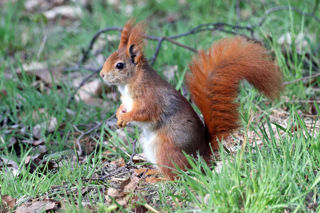
Red Squirrel
Sciurus vulgaris
The Red squirrel is one of the most charismatic of British mammals. They are smaller than the Grey Squirrel with a deep red coat, a creamy white under belly, distinctive ear tufts and a long bushy tail. Their tails are very important to them, as it helps them to balance on high thin branches.
It acts as a means of communication; a swishing motion indicates it is alarmed, and the tail can give extra warmth as it curls over its
back.
Behaviour
Red Squirrels are active in the early mornings and in the afternoons. They prefer to sleep during midday in their dreys high in the trees, which are constructed of twigs, lined with moss, grass and hair. These dreys are used for napping, and rearing their young.
In the depths of cold winters, they do not hibernate, but reduce their active time and share their dreys with related squirrels for extra body warmth. Their other main autumn and winter activity is hiding/storing food items to see them through the cold months.
Known as caching, they spend a lot of time burying tree nuts, some of
which are never retrieved, and so in turn, can grow into tree saplings and improve the forest ecosystem.
UK Status
Once common throughout the UK, the Red Squirrel’s distribution is now determined by the presence or absence of Grey Squirrels. Red Squirrels are extinct from England apart from the northern counties, particularly Cumbria and Northumberland. Islands, if suitable, give populations a refuge from greys, so the Isle of Wight, Poole and
Brownsea, Isle of Anglesey in Wales, and Mersea contain Red Squirrels. Wales have two, at risk mainland populations, but the stronghold is in Scotland.
There are approximately 140,000 red squirrels in the UK of which, approximately 120 000 are in Scotland. On the other hand, the numbers of Grey Squirrels are approaching 3 million in the UK.
Threats
Historically, habitat loss and fragmentation have been the main threats to this species. With the introduction and spread of the non-native Grey Squirrel (Sciurus carolinensis) in the late 1800s, this is now the main threat. Grey Squirrels out compete Reds Squirrels as they live in greater densities and are more successful in obtaining food resources than reds. They also carry a virus known as squirrelpox which greys are immune to but for Red Squirrels, it is fatal.

Distribution
Large global range from the UK Northeast China. Also found on Pacific islands. They are widespread within Europe except in the UK and
the Iberian Peninsula.
Habitat
In the absence of greys, they favour broad leaf deciduous woods, mixed forests of conifers and broadleaf along with parks and gardens. They now use coniferous forests as a refuge in the presence of greys as, in this habitat, they are able to withstand competition from the grey. They are able to utilise the feed items of a conifer forest more successfully than Grey Squirrels.
Diet
Red Squirrels are general, opportunistic, seasonal feeders. The seeds and nuts of conifer and broadleaf trees dominate their diet, however when these are not available a wide variety of food items are selected. In Spring they feed on catkins, tree buds, shoots, and flowers. In the Summer the variety is reduced, and they are known to take insects and occasional bird eggs. Autumn provides the most important feed crop in
tree seeds and nuts and this is why they cache so much then. A wide variety of fungi is also taken in the autumn.
Wildwood inside information
We have a history of successful breeding which has contributed to UK reintroduction projects. For more information on our Red Squirrel captive breeding and reintroductions visit our conservation page.
Family facts
Red Squirrels can be either left handed or right handed as they pick up feed items.
A Red Squirrel can detect buried nuts a foot under snow.
-
![Red Squirrel Ground]()
Wildwood animal adoptions last for one year and are the perfect gift for any animal lover. Each adoption helps support our work to save British wildlife. We have different levels of adoption available to suit all occasions and budgets.
Adopt me!
-
![B60I2430]()
Wildwood Trust has successfully bred Red squirrels for twenty years and contributed to the reintroduction projects of Anglesey Island, and Clocaenog Forest in Wales. We have joined forces with other major captive breeding collections to implement a national captive breeding group.
Read me!



